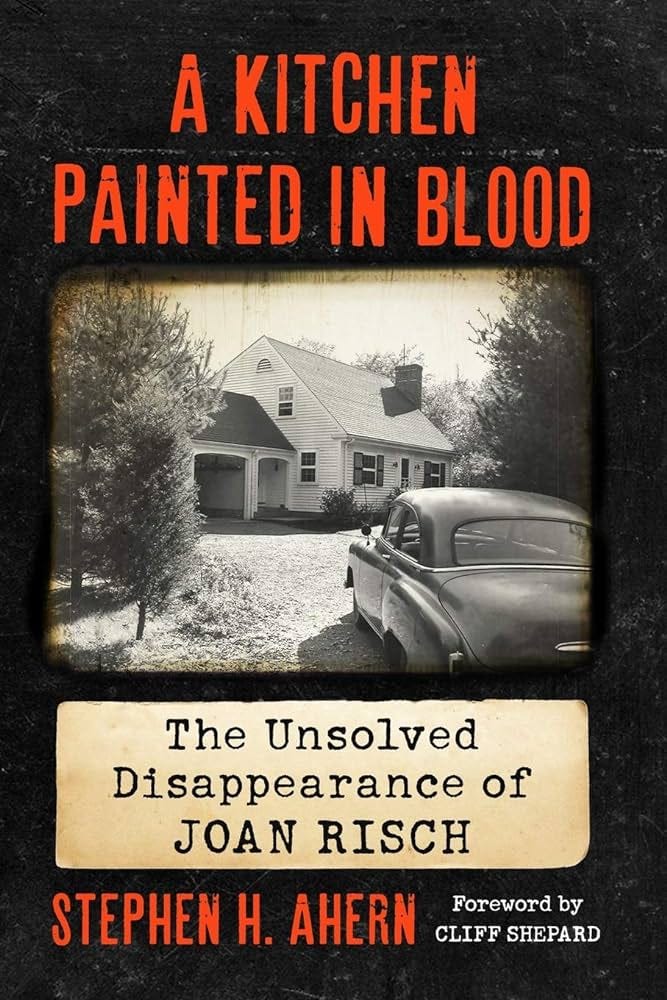I’ve always been fascinated by mysterious disappearances. Others must be as well. Wikipedia used to have a single dedicated page, “List of People Who Disappeared Mysteriously,” but now there are several, broken down by time period, and all continue to grow as more stories are added. To be fair, they’re not all so mysterious- “explorer went into the arctic and was never seen again” or “former mafia capo last seen the day before he was set to testify against the don” don’t exactly stretch the resources of the imagination, though of course, one might concede the possibility of poor Anthony Strollo being abducted by aliens shortly after betraying Vito Genovese, laughing as he’s beamed up into the mothership at the assumptions those left behind would no doubt make.
Actually strangled by Sasquatch? A new History Channel series asks the hard questions…
For many, perhaps, the allure of a disappearance is voyeuristic, the thrill of some dark look into the private aspects of someone’s life. The True Crime genre is sometimes criticized along those lines. Once something is labeled an investigation it seems, the normal restrictions of propriety relax to the degree that the details stimulate strong emotions, as sex and violence tend to do. People fill chat rooms debating whose semen was where, whether a woman’s throat was cut with a razor or a kitchen knife, or whether a kidnapped toddler is currently being sex trafficked. Stark as it is in my description here it makes for uncomfortable reading, but it’s the stuff elderly women regularly consume on Investigation Discovery. One can also approach it from the other direction, coldly and clinically as a problem to be solved, removing the human element and treating it like a game of sorts. This is favored in fictional true crime narratives, as it puts a kind of emotional distance between the act and the detective, which is to say, the reader or viewer. He’s not looking through the window at something he shouldn’t, he’s solving a crime- that the young French maid was suffocated with her own stockings is just a detail among many.
This is the French maid costume from the Walmart website. She may actually be intending to clean your house. #dontatme #nothatin #BBWlove
For me, however, it’s a bit different. I like to explore disappearances because they foreground an aspect of life we too often forget. Surrounded as we are by cameras and computer surveillance, by networks of family and friends and millions of stranger’s eyes, we are not so fixed into the world as we like to believe. Every now and then, to seemingly random people, something unexpected comes along an snatches them away, never to be seen again. What’s left behind is like a shipwreck, bits and pieces bobbing in the waves, and those who come upon the scene are left to put together a puzzle with the most important pieces having sunk into darkness.
I listen to videos about cases when I hike alone in the woods. It focuses my mind on my vulnerability (I can still hear around me; I’m no ironist) and on the fact that were something to happen it might be a while before anyone ever knew what happened. I got lost once on a very long trail, to the degree that I had recourse to a compass, and had to wander for some two hours before I found my path, having a close encounter with a black bear along the way. Had things gone differently, had I slipped and twisted an ankle, or been bitten by a rattlesnake, or ended up as that bear’s lunch, though I was never more that two miles from a visitor center full of tourists it would have been as though I were on the moon as far as the rest of humanity was concerned. Now, I probably would have been found eventually, and the mystery solved, and if not, people probably would have made the correct assumptions- my car was parked at the trailhead, I was not known for having the best sense of direction, the discovery of bear scat smelling of sigma male. They would all, friends and family and anyone encountering the story, resolve the mystery to their satisfaction, and having done so, it would be forgotten.
But that’s not true of all of them. In 1946, Paula Jean Welden, 18, went walking on the Long Trail near Bennington College in Vermont and was never seen again. The trail was and is well-marked and there were no signs of any injury or crime, or any indication she wished to leave on her own. The area is in the midst of what is known as the Bennington Triangle, however, and known for . . . oddities. All that is known for certain is that she stepped onto the trail and out of human awareness. Closer to our own time is the 2004 case of Maura Murray, 21, last seen parked roadside after having sideswiped a guardrail near Woodsville, New Hampshire and telling an inquiring passer-by that she’d already called a tow truck (she hadn’t). It turned out that the seemingly clean-cut track star and nursing student’s life was a tangle of lies and bizarre petty crimes, and it may be that she disappeared while trying to disappear. She has not been accounted for since. The 1945 case of the Sodder Children is too strange to summarize; that of Brian Shaffer in 2006 more like a fictional locked door mystery than a tragic real life missing person’s case. And those are just a few of the famous ones; countless others without a pretty young coed or a a family to pursue media attention await discovery by bloggers and vloggers, their obscure details put into videos on channels like Missing Void and Dark Curiosites, among many others. Those that gain more attention might make it to Disappeared on Discovery. What unites them, the well-known and less-so, is one thing- they make no sense. And that, more than anything, is what makes them so compelling.
Joan Risch
Take, for example, the case of Joan Risch. On October 24th, 1961, Mrs. Risch, 31, was a Massachusetts housewife and mother of two going about her daily errands while her husband was on a business trip in New York. At around 1:55 pm she walked her older daughter, 4, across the street to play with a neighbor’s son. Her other child, a toddler, was asleep in his crib at home. The neighbor saw Joan outside around 2:15, wearing a trenchcoat, either holding or pursuing something “red.” She later heard some kind of shouting noise, with what she described as a “scolding” tone. Two people reported an unusual car in the Risch driveway around 3:30, perhaps a dirty ‘54 Plymouth, but no one could be sure exactly; the car probably departed around 3:40. The neighbor walked Joan’s daughter back to the Risch’s yard at 3:45, but didn’t see Joan and didn’t see the strange car. The daughter went inside and stayed some thirty minutes there before she returned to the neighbor’s house and informed her friend’s mother that her mommy wasn’t home, her brother was crying in his crib, and the kitchen was covered in red paint…
Entering the house with another neighbor, she discovered that the kitchen was in fact covered in blood. Joan’s son was fortunately safe upstairs, but the scene was clearly bad and they called the police immediately. The investigation revealed that the phone had been ripped off the wall and thrown into a trash can, that there was a phonebook open to the page with emergency numbers, and that someone had attempted to clean up the blood before giving up. There was blood on the walls and the floor, in spots in other places in the house, and on Joan’s car outside. The garbage can contained a number of empty beer bottles, the provenance of which her husband, contacted and hurrying home, could not explain. At least three sightings of a woman or women, bleeding and staggering along nearby roads, were reported to police, but nothing certain was made of them (nor did anyone attempt to help). Bloodhounds could not hit a trail beyond the driveway.
The Risch home
Did she have some accident? If so, why tear the phone off the wall, and where did she go? No one saw her walking in the neighborhood, and why would she have wandered off anyway with people nearby who could help her? Was she attacked, an assailant injuring her in her kitchen? If so, why take her from her home (this was a time before DNA could be traced and such)? Why try to clean up, who was looking up emergency numbers, and why no scream for help? A few unidentified fingerprints were found in the house, but whoever they belonged to had no criminal record, or any existence in the system. No other crime, if this even was a crime, was in evidence. There were no signs of a struggle. There had been no ransacking of the house, her purse and belongings were all intact; she’d taken nothing with her but the clothes on her back, and left her two children alone. They never saw their mother again, nor did anyone else. Despite a search that lasted years, reward offers, and enormous local publicity, the case remains unsolved to this day, without even a clear idea of what was being investigated.
A mystery is a fearful thing- like a joke, it provokes a sense of unease, though chronic rather than acute. But when someone knock-knocks, we expect them to announce who’s there. Cases like that of Joan Risch offer no such resolution. Questions pile atop questions and rumors start to fill the gaps that create such a sense of fearful emptiness in the mind. The weird details of even a short and mundane life take on added significance. For instance, Risch- by all accounts a profoundly ordinary woman without serious problems or enemies- was not unacquainted with odd tragedies. Her own parents had died in an unexplained fire when she was nine, while she was away from home, just as her own husband had been absent for her own loss. She had gone to live with relatives; hearsay spoke of her adoptive father, her maternal uncle, sexual abusing her.
She’d overcome a lot. Escaping somewhat straightened circumstances she’d gone to college and studied English, was well-read, and had been a professional before the kids came along. Her husband was a rapidly rising executive who travelled on business often. By all accounts they were happy; she was a doting mother and they were prosperous (the neighborhood was well-to-do, near Walden Pond). But you never really know, do you?
Local neckbeards were rounded up for questioning
It’s easy for the more prurient parts of our imaginations to take over, conditioned by a culture of deconstruction and irony. This 1950s housewife, with her white picket fence existence- surely, there must have been . . . issues. An affair- husband with money just happens to be in New York when his wife’s blood is being sprayed all over the linoleum? Or perhaps her own dalliance- a bored, educated women stuffed into suburbia, goes too far with that man from the library, gets ‘in trouble’ and has to avail herself of the services of the kind of doctor who shows up in a filthy, beat-up Plymouth, things go wrong, he can’t let her call the ambulance now, can he..? Perhaps the stepfather, worried that his secrets might be exposed, decided to silence her before she could ruin him before his family- there was no sign of an forcible intruder, but he could have talked his way in, and he was certainly a beer-drinker…
None of that really makes sense, though. Joan’s husband, Martin, by all accounts loved his wife deeply, and she him. He never remarried or left the area, living alone with her memory for forty-nine further years. There was no evidence Risch was unhappy with her life and every account of her speaks to her fitting in well in her community. Her professional aspirations were certainly on hold as a young mother, but she and Martin had spoken of her returning to work when the kids were old enough for school, which was a common arrangement at the time and to which they were both amenable. There was no evidence that she was pregnant and the idea that she would schedule an abortion during a brief window when her daughter was playing across the street and could return with the neighbor anytime stretches credulity. Her stepfather had an alibi; the allegations of abuse, while credible, were never proved, and though she had a stepbrother whose whereabouts remain somewhat disputed during that time those were not his fingerprints in the house. The idea that her adoptive family, whom Joan and Martin themselves were assisting financially, had the knowledge and resources to hire a hitman, or would, is also a stretch.
This is probably the best book on the subject, and I won’t spoil it by saying what theory the author advances.
It’s all absurd, and yet it happened. The pieces are all there, floating in that Sea of Unknowing, bits of a shipwrecked life. But what is planking, and what is driftwood? What belongs and what does not, and what is missing besides? Did the car in the driveway even matter, or was it merely given significance for its proximity to the case? What about the mystery woman or women seen bleeding along the nearby highways- perhaps memories given post hoc shaping by needs of rationalizing minds. Her library check-out list contained a good bit of Agatha Christie and such- was this a sign she was planning to disappear? If so, she did a better job than Mrs. Christie, but festooning your kitchen with your own blood is a poor way of getting people not to look for you. All absurd, every part of it, and yet all the pieces somehow add up to a whole, to the story of what happened to Joan Risch.
Somewhere, out there in that Sea of Unknowing, far below the waves in places beyond the reach of the minds of men lies the truth. In some way they’re gathered in some abyssal grotto, Joan and Paula and Maura and all the rest, hidden from us, their absence mocking our pretense that the world is safe and knowable, and that we ourselves are immune to being swept away in a sudden storm, carried by the waves of an unknown force to a destiny no living person can know. We can try- people will no doubt try in the comments- but for my part, I recall the words of the Tentmaker-
With them the Seed of Wisdom did I sow,
And with my own hand labour'd it to grow:
And this was all the Harvest that I reap'd --
"I came like Water and like Wind I go."











You know I have my gnostic tendencies, so I see our existence itself as mysterious, with anomalies in all the conventional explanations -- but even under the orthodox Christian view, there's so much about the context within which our world sits, that much remains unanswered and, for now, unanswerable (at least for us). I think the mysterious, whether in art or history or sensational news stories, appeals to us because it awakens within us a deeper longing to have the disconnected jigsaw puzzle pieces of our existence finally form a complete picture.
“The true magic of this broken world lay in the ability of the things it contained to vanish, to become so thoroughly lost, that they might never have existed in the first place.”